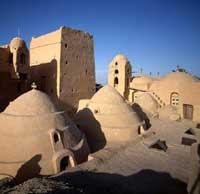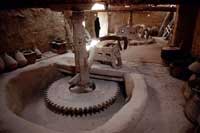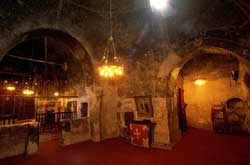|
The monastery of
Saint Anthony
 Saint Anthony is often called "the Father of the Monks". He is
credited with the founding of Christian monasticism, and many of
his ideas are still used to this day by modern monks and nuns.
Most of what we know about Anthony comes from the writings of
Saint Athanasius the Apostolic, a disciple and close friend of
Anthony's. Anthony was born about AD 251 and was the son of a
well-to-do family from middle Egypt. When he was eighteen his
parents died, leaving him sole guardian of his younger sister
Dious. Six months later, while attending a church, he heard the
scripture passage of Jesus and the rich young man, in which
Jesus says, "If you would be perfect, go, sell all you have,
give to the poor, and follow me (Matt. 19:21)." He took this as
a personal invitation from God and sold most of his inherited
property, gave much of the money to the poor and the rest to his
sister and placed his sister in the care of a community of holy
women. He sought guidance from a holy man near Coma in the ways
of the Christian ascetic: prayer, fasting, and holiness. After a time of study,
Saint Anthony left on his own and began living in the manner of
a mountain hermit, living in a cave and praying for the
salvation of the world. At the age of thirty-five, he moved to
Pispir and remained there in solitude for twenty years. During
that time, many came to live near him and copy his holy life. He
became their spiritual leader, teaching them by word and by
example the life of the ascetic. Anthony also taught them to
perform manual labor between prayer times as an additional
contribution to society. Saint Anthony is often called "the Father of the Monks". He is
credited with the founding of Christian monasticism, and many of
his ideas are still used to this day by modern monks and nuns.
Most of what we know about Anthony comes from the writings of
Saint Athanasius the Apostolic, a disciple and close friend of
Anthony's. Anthony was born about AD 251 and was the son of a
well-to-do family from middle Egypt. When he was eighteen his
parents died, leaving him sole guardian of his younger sister
Dious. Six months later, while attending a church, he heard the
scripture passage of Jesus and the rich young man, in which
Jesus says, "If you would be perfect, go, sell all you have,
give to the poor, and follow me (Matt. 19:21)." He took this as
a personal invitation from God and sold most of his inherited
property, gave much of the money to the poor and the rest to his
sister and placed his sister in the care of a community of holy
women. He sought guidance from a holy man near Coma in the ways
of the Christian ascetic: prayer, fasting, and holiness. After a time of study,
Saint Anthony left on his own and began living in the manner of
a mountain hermit, living in a cave and praying for the
salvation of the world. At the age of thirty-five, he moved to
Pispir and remained there in solitude for twenty years. During
that time, many came to live near him and copy his holy life. He
became their spiritual leader, teaching them by word and by
example the life of the ascetic. Anthony also taught them to
perform manual labor between prayer times as an additional
contribution to society.
 When the persecutions began again against the Christians in
Egypt at the hands of Maximinus Daia in the early 300s, he went
to Alexandria and ministered to those in prison. After the
persecutions ended, he returned to his life of solitude. He
returned to Alexandria once more to support Pope Athanasius
against the Arian Heresy in 352, and many came to see the aged
holy man as he walked through the city, but he returned to his
desert soon after, society no longer having any hold on him.
Contrary to popular belief, Anthony founded no formal monastery
and his Rule was simply work and prayer. Anthony also designed
the first monastic uniform, an all-purpose robe of white linen
fastened about the waist with a sturdy leather belt. This has
become the basic pattern for monastic garb all over the world
and in all times since. Many came to Saint Anthony for advice,
spiritual help, and healing. Saint Anthony died in 356 at the
age of one hundred and five and was buried secretly by Macarius
and Amatas, two of his most loyal monks. When the persecutions began again against the Christians in
Egypt at the hands of Maximinus Daia in the early 300s, he went
to Alexandria and ministered to those in prison. After the
persecutions ended, he returned to his life of solitude. He
returned to Alexandria once more to support Pope Athanasius
against the Arian Heresy in 352, and many came to see the aged
holy man as he walked through the city, but he returned to his
desert soon after, society no longer having any hold on him.
Contrary to popular belief, Anthony founded no formal monastery
and his Rule was simply work and prayer. Anthony also designed
the first monastic uniform, an all-purpose robe of white linen
fastened about the waist with a sturdy leather belt. This has
become the basic pattern for monastic garb all over the world
and in all times since. Many came to Saint Anthony for advice,
spiritual help, and healing. Saint Anthony died in 356 at the
age of one hundred and five and was buried secretly by Macarius
and Amatas, two of his most loyal monks.
St. Anthony's Monastery (Deir Mar Antonios), and its neighbor
St. Paul's, are the oldest monasteries founded in the Egyptian
desert . Hidden deep in the Red Sea Mountains and relying on
springs for their water supply, both still observe rituals that
have hardly changed in 16 centuries.
 St. Anthony's was founded in 356 AD, just after the saints
death. Between the 12th and 15th centuries, the monastery
flourished but was plundered in 1454 by Bedouin servants. Today
it is a self-contained village with gardens, a mill, a bakery
and five churches with exceptional wall paintings of holy
knights in3 bright colors and the hermit founders of the
monastery in subdued colors and icons. There is also a library
with over 1,700 handwritten manuscripts, but the Bedouin
servants who plundered the monastery used many manuscripts for
cooking fuel. At one time, there must have been a much more
extensive library. St. Anthony's Cave (magharah), where he lived
as a hermit, is a 2 km hike from the monastery and 680 m. above
the Red Sea. It offers stunning views of the mountains and the
sea, and the chance to see a wide range of bird life. St. Anthony's was founded in 356 AD, just after the saints
death. Between the 12th and 15th centuries, the monastery
flourished but was plundered in 1454 by Bedouin servants. Today
it is a self-contained village with gardens, a mill, a bakery
and five churches with exceptional wall paintings of holy
knights in3 bright colors and the hermit founders of the
monastery in subdued colors and icons. There is also a library
with over 1,700 handwritten manuscripts, but the Bedouin
servants who plundered the monastery used many manuscripts for
cooking fuel. At one time, there must have been a much more
extensive library. St. Anthony's Cave (magharah), where he lived
as a hermit, is a 2 km hike from the monastery and 680 m. above
the Red Sea. It offers stunning views of the mountains and the
sea, and the chance to see a wide range of bird life. |